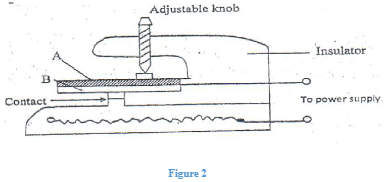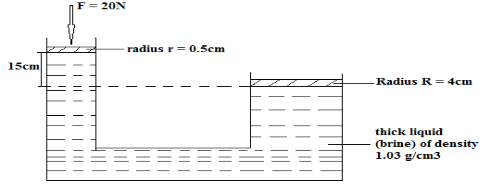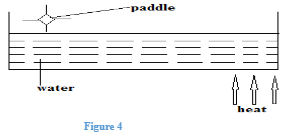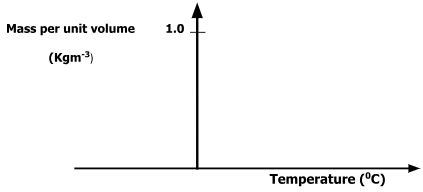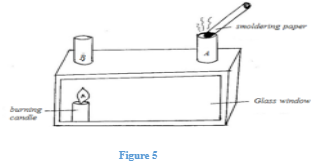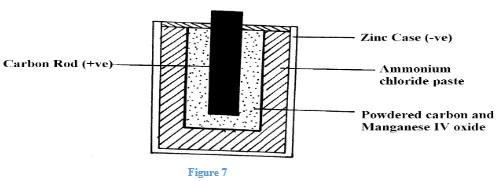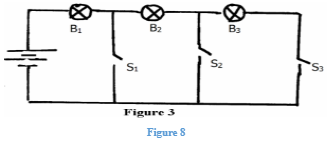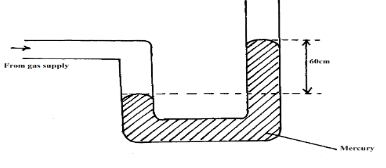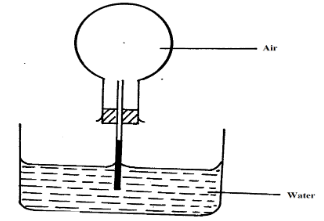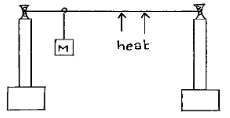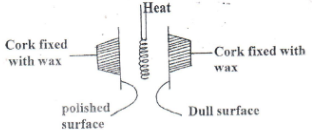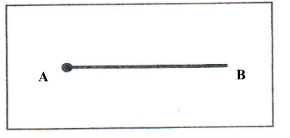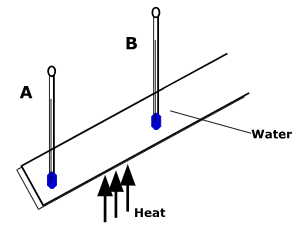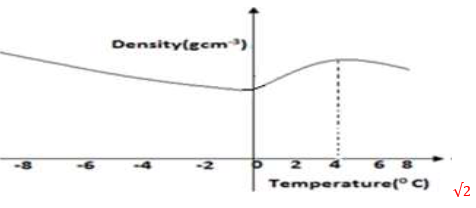Instructions to candidates
- This paper consists of two sections: section A and section B
- Answer all questions in both section in the spaces provided
- All working must be clearly shown
- Electronic calculators may be used.
SECTION A (25 MARKS)
Answer ALL the questions in the spaces provided
- Highlight two facts which show that the heat from the sun does not reach the earth surface by convection. (2 marks)
- The diagram below shows the essential features of a solar heating panel. A small electric pump circulates the liquid through the pipes.
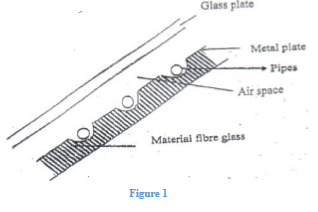
State briefly why:- The pipes and metal plates are blackened. (1mark)
- There is a material fibre glass on the panel. (1mark)
- The figure below shows an electric iron
Two metal plates A and B are riveted to form a bimetal strip as used above.- Which metal expands more (1mark)
- Explain how the electric iron works when the power is on (2 marks)
- Given that a material X of density 8.5g/cm3 is attached to a piece of wood of mass 100g and density 0.2g/cm3. Calculate the volume of material X which must be attached to the piece of wood so that the two together just submerge beneath liquid of density 1.2/cm3. (3 marks)
- The mass of a lump of gold remains constant wherever it may be shifted to. Explain (1 mark)
- The figure 3 below shows a hydraulic p
Figure 3- Determine the maximum load that can be pressed by the machine. (3marks)
- State one property of the brake fluid. (1mark)
- A pollen grain is placed in water, state and explain the direction in which it moves. (2marks)
- The figure 4 below is a paddle wheel made of a light material and is well-oiled. In which direction will it rotate?
- In which direction will it rotate? (1mark)
- Two thin blankets are warmer than a single thick one. Explain. (`1mark)
- Sketch a graph of density against temperature of water cooling from 10°C to 0°C.(2marks)
- In an experiment investigating Browniam Motion, smoke particles are used. State any two reasons why smoke particles are suitable for this experiment. (2 marks)
- Figure 4 below shows a smoke box with two chimney A and B.
A moldering paper (producing smoke) is placed at the mouth of chimney A and a piece of burning candle is placed under chimney B as shown. Sketch on the diagram what is likely to be observed. Explain your answer in (i) above. (2marks) - The figure below shows the level of water in a measuring cylinder. 20 lead shots each of volume 0.5cm3 are dropped into the water. Indicate on the diagram the new water level. (2 marks)
SECTION B (55 MARKS)
Answer ALL questions in the spaces provided
- The figure below shows the features of a dry leclanche cell. Use the information to answer the questions which follow.
- What is the source of energy in the above dry cell? (1mark)
- What is the function of:
- Manganese IV Oxide (1mark)
- Powdered carbon (1mark)
- A student connected the circuit as in fig 3. State what happens when S2 is closed (1mark)
- State the basic law of electrostatic charges. (1mark)
- State the observation on the leaves of a positively charged electroscope when a negative charge is brought near it. (1mark)
- Name two measurements you would need to determine whether a lead acid accumulator is fully charged. ( 2marks)
-
- Define pressure. (1mark)
- A student of a certain school connected a U-tube to a gas supply in the laboratory and obtained the readings as shown below.
Figure 9
Given that the density of mercury is 13600kg/m3 and the atmospheric pressure is 760mm Hg. Determine the gas pressure in mmHg. (3marks) - State three properties of a suitable hydraulic fluid. (3marks)
- A hole of diameter 1.0mm is made in the side of a water pipe. If the Pressure of the flow is maintained at 3.0 X 106Nm-2, calculate the force with which the water jets out of the hole. (3marks
- A block of dimension 0.2m by 0.1m by 5cm has a mass of 500g and rests on a flat surface. Determine the least pressure that can be exerted by the block on the surface. (3marks)
- Some water is poured in two test tubes, one painted black and the other one polished. The apparatus were set up as shown and left in the sun for some times.
Figure 10- State which thermometer records a higher reading after 20minutes. Give a reason for your answer. (2 marks)
- The figure below shows a flask fitted with a glass tube into a beaker containing water at room temperature.
Figure 11
Explain what is observed when the flask is held with warm hands. (2marks) - The mass M was suspended from a tight copper wire using a rider as shown .The copper wire was then heated.
Figure 12
State what was observed on the position of M as the wire was heated for some time. (1 mark) - Figure 3 below shows two pieces of cork fixed on a polished and a dull surface with wax.
Figure 13
State and explain the observation made, when the heater is switched on for a short time given that the heater is equidistant from the two surfaces. (2marks)
-
- List three effects of force. (3marks)
- State 3 ways how one can reduce friction in the moving parts of a machine. ( 3 marks )
- Distinguish between mass and weight of a body stating the units for each. ( 2 marks )
- Name two types of forces which can act between objects without contact ( 2 marks )
- Figure 14 below shows a matchstick soaped on one end (end A) and placed on the surface of water.
Figure 14- The matchstick is moved observed to move in a certain direction. State the direction and explain your answer. (2marks)
- A crystal of potassium permanganate was carefully introduced at the bottom of water column held in a gas jar. After sometimes the whole volume of water was coloured.
- Explain this observation. (1mark)
- State the effect of using warm water on the observation above. (1mark)
- Figure 15 below shows a ray of light being incident on a mirror.
Figure 15- What is the angle of reflection? (1mark)
- State the effect if any when there is an increase in the size of the hole of a pinhole camera to;
- The size of image. (1 mark)
- The brightness of image. (1 mark)
- The sharpness of image. (1 mark)
- Suggest;
- How the thermal conductivity of a metal depends on its temperature (1 mark)
- Why most ceiling boards in hot areas should be painted white (1mark)
- Distinguish between natural and forced convection currents (2marks)
- The figure below shows a glass tube with water fitted with two identical thermometers A and B. It is heated as shown.
Figure 16- Explain the observation made in the reading of the thermometers above. (2marks)
- State how in the vacuum flask, heat loss is reduced by; (3marks)
- Radiation;
- Conduction;
- Convection;
MARKING SCHEME
SECTION A (25 MARKS)
Answer ALL the questions in the spaces provided
- Highlight two facts which show that the heat from the sun does not reach the earth surface by convection. (2 marks)
- Convection takes place upwards due to density effects√1
- Convection requires material medium but space from sun and atmosphere has no material medium√1
- The diagram below shows the essential features of a solar heating panel. A small electric pump circulates the liquid through the pipes.
State briefly why:- The pipes and metal plates are blackened. (1mark)
- To increase rate of absorption of heat√1
- There is a material fibre glass on the panel. (1mark)
- It acts is an insulator and prevents heat loss from the pipes√1
- The pipes and metal plates are blackened. (1mark)
- The figure below shows an electric iron
Two metal plates A and B are riveted to form a bimetal strip as used above.- Which metal expands more (1mark)
- Metal A√1
- Explain how the electric iron works when the power is on (2 marks)
- When the switch is closed, metal A expands more than B hence breaking the contact. √1
- Since no current flows, cooling takes place, A cools faster than Bhence making the contact. √1
- Which metal expands more (1mark)
- Given that a material X of density 8.5g/cm3 is attached to a piece of wood of mass 100g and density 0.2g/cm3. Calculate the volume of material X which must be attached to the piece of wood so that the two together just submerge beneath liquid of density 1.2/cm3. (3 marks)
Density of mixtures = total mass √1
total volume - The mass of a lump of gold remains constant wherever it may be shifted to. Explain (1 mark)
- Mass is the quantity of matter in a substance, it is constant everywhere. √1
- The figure 2 below shows a hydraulic press
- Determine the maximum load that can be pressed by the machine. (3marks)
P1 = P2√1
F1 + hρg = F2
A1 A2
20N + 0.15 × 1030Kgm-3 × 10 = F2 √1
(0.0052×π) 0.042×π
F2=√1 - State one property of the brake fluid. (1mark)
- Should be in-compressible
- Have low freezing and high boiling point.
- Should not corrode the parts of the brake system.
- Determine the maximum load that can be pressed by the machine. (3marks)
- A pollen grain is placed in water, state and explain the direction in which it moves. (2marks)
- It moves in a constant random motion√1 due to uneven bombardment with invisible particles of water. √1
- The figure 4 below is a paddle wheel made of a light material and is well-oiled. In which direction will it rotate?
- In which direction will it rotate? (1mark)
- Anticlockwise√1
- Two thin blankets are warmer than a single thick one. Explain. (`1mark)
- Air trapped between the two thin blankets is a good insulator/ poor conductor of heat, hence it prevents heat loss from the body. √1
- In which direction will it rotate? (1mark)
- Sketch a graph of density against temperature of water cooling from 10°C to 0°C. (2marks)
- In an experiment investigating Brownian Motion, smoke particles are used. State any two reasons why smoke particles are suitable for this experiment. (2 marks)
- They are light √1
- They are visible√1
- Figure 4 below shows a smoke box with two chimney A and B.
A moldering paper (producing smoke) is placed at the mouth of chimney A and a piece of burning candle is placed under chimney B as shown. Sketch on the diagram what is likely to be observed. Explain your answer in (i) above. (2marks)- √1- Award first mark for correct sketching of convectional currents in the box.
- √1 The candle causes hot air above it to rise, setting up convectional currents in the box.
- The figure below shows the level of water in a measuring cylinder. 20 lead shots each of volume 0.5cm3 are dropped into the water. Indicate on the diagram the new water level. (2 marks)
Volume of lead shots = 20×0.5=10cm3√1
New volume =10 +8=18cm3√1
SECTION B (55 MARKS)
Answer ALL questions in the spaces provided
- The figure below shows the features of a dry leclanche cell. Use the information to answer the questions which follow.
- What is the source of energy in the above dry cell? (1mk)
- From chemical reaction/ electrolytes/ chemical energy √1
- What is the function of:
- Manganese IV Oxide (1mk)
- Acts as a depolarizer √1
- Powdered carbon (1mk)
- Acts as an electrode/ increases the surface area of the carbon electrode. √1
- Manganese IV Oxide (1mk)
- A student connected the circuit as in fig 3. State what happens when S2 is closed (1mk)
- Bulb B1 and B2 light while B3 does not light. √1
- State the basic law of electrostatic charges. (1mk)
- Like charges repel, unlike charges attract. √1
- State the observation on the leaves of a positively charged electroscope when a negative charge is brought near it. (1mk)
- The leaf falls/ the leaf divergence decreases√1
- Name two measurements you would need to determine whether a lead acid accumulator is fully charged. ( 2mks)
- Relative density of the electrolyte√1
- E.M.F / voltage of the battery. √
- What is the source of energy in the above dry cell? (1mk)
-
- Define pressure. (1mk)
- Force acting normally per unit area√1
- A student of a certain school connected a U-tube to a gas supply in the laboratory and obtained the readings as shown below.
Given that the density of mercury is 13600kg/m3 and the atmospheric pressure is 760mm Hg. Determine the gas pressure in mmHg. (3mks)
Pgas = hρg + Patmospheric√1
Pgas = 0.6×13600×10+(0.76×13600×10) √1
Pgas = 81600 + 103360 = 184960Pascals√1 - State three properties of a suitable hydraulic fluid. (3mks)
- Incompressible√1
- Non corrosive√1
- High boiling point and low freezing point√1
- A hole of diameter 1.0mm is made in the side of a water pipe. If the Pressure of the flow is maintained at 3.0 X 106Nm-2, calculate the force with which the water jets out of the hole. (3MARKS)
F=P×A√1
F=(3×106)×(0.001)2 ×π√1
2
F=0.75N√1 - A block of dimension 0.2m by 0.1m by 5cm has a mass of 500g and rests on a flat surface. Determine the least pressure that can be exerted by the block on the surface. (3marks)
Minimuum pressure = Force √1
Max area
= 5N
0.2×0.1 √1
= 250Pascals√1
- Define pressure. (1mk)
- Some water is poured in two test tubes, one painted black and the other one polished. The apparatus were set up as shown and left in the sun for some times.
- State which thermometer records a higher reading after 20minutes. Give a reason for your answer. (2 marks)
- A √1
- It is polished, polished surfaces are good reflectors of heat/ poor emitters of heat while hence keep their heat for longer unlike black surfaces that are good emitters of heat hence rapidly lose their heat to the surrounding environment resulting to lower temperature. √1
- The figure below shows a flask fitted with a glass tube into a beaker containing water at room temperature.
Explain what is observed when the flask is held with warm hands.(2mk)- The level of liquid in the tube/straw drops/falls. √1
- Air in the flask expands when heated to push down the liquid√1
- The mass M was suspended from a tight copper wire using a rider as shown .The copper wire was then heated.
State what was observed on the position of M as the wire was heated for sometime. (1 mark)- The position of the mass lowers/ drops/ sags as the copper wire expands when heated. √1
- Figure 3 below shows two pieces of cork fixed on a polished and a dull surface with wax.
State and explain the observation made, when the heater is switched on for a short time given that the heater is equidistant from the two surfaces. (2marks)- The cork fixed on the dull surface drops off fast. √1
- Dull surfaces are good absorbers of heat, hence the wax on them melts fast and the cork drops . √1
- State which thermometer records a higher reading after 20minutes. Give a reason for your answer. (2 marks)
-
- List three effects of force. (3mks)
- Force can make stationary object move. √1
- It can increase speed of moving object. √1
- It can stop a moving object. √1
- It can decrease speed of moving object.
- It can change shape of an object (i.e. can deform an object).
- It can make an object turn about a fixed point (pivot).
- It can change the direction of a moving object.
- State 3 ways how one can reduce friction in the moving parts of a machine. ( 3 marks )
- Oiling and greasing. √1
- Using rollers. √1
- Streamlining bodies. √1
- Smoothening surfaces. √1
- Using ball bearings. √1
- Distinguish between mass and weight of a body stating the units for each. ( 2 marks )
- Mass is defined as the quantity of matter in a body while Weight is the gravitational pull on a body. √1
- SI unit of weight is Newton (N) while mass is Kilogram Kg√1
- Name two types of forces which can act between objects without contact ( 2 marks )
- Magnetic force, √1
- Gravitational force, √1
- Electrostatic force√1
- List three effects of force. (3mks)
- Figure 14 below shows a matchstick soaped on one end and placed on the surface of water.
- The matchstick is moved observed to move in a certain direction. State the direction and explain your answer. (2 marks)
- B. √1
- The soap at the end of the stick immediately dissolves in water, thereby lowering the surface tension at the end of the stick. The surface tension at the other end which is now greater pulls the stick and makes it move in that direction. √1
- A crystal of potassium permanganate was carefully introduced at the bottom of water column held in a gas jar. After sometimes the whole volume of water was coloured.
- Explain this observation. 1mk
- This is due to diffusion, the movement of particles from a region of high concentration to region of low concentration √1
- State the effect of using warm water on the observation above. 1mk
- The potassium permanganate diffuses faster. Or The liquid turns purple faster√1
- Explain this observation. 1mk
- The matchstick is moved observed to move in a certain direction. State the direction and explain your answer. (2 marks)
- Figure 15 below shows a ray of light being incident on a mirror.
- What is the angle of reflection? 1mk.
- 42° √1
- State the effect if any when there is an increase in the size of the hole of a pinhole camera to;
- The size of image. (1 mark)
- The image size remains the same√1
- The brightness of image. (1 mark)
- The additional brightness of the resultant image is due to more light which now gets into the camera through the enlarged hole. √1
- The sharpness of image. (1 mark)
- The image appears blurred due to the overlapping of different images falling on the same area of the screen√1
- The size of image. (1 mark)
- Suggest;
- How the thermal conductivity of a metal depends on its temperature (1 mark)
- The higher the temperature difference, the higher the conductivity√1
- Why most ceiling boards in hot areas should be painted white (1 mark)
- White surfaces are good reflectors of radiant heat/ poor absorbers of radiant heat, hence they keep the room cool. √1
- Distinguish between natural and forced convection currents (2 marks)
- Natural convection: Involves change in density of the fluid with temperature√1 while Forced convection: Mixing of hot and cold parts of the fluid through some external stirring, like a fan or pump. √1
- How the thermal conductivity of a metal depends on its temperature (1 mark)
- The figure below shows a glass tube with water fitted with two identical thermometers A and B. It is heated as shown.
- Explain the observation made in the reading of the thermometers above. (2marks)
- After sometimes it is observed that the thermometer at the top of the tube (B) records a higher while the thermometer at the lower end (A) records a lower temperature. . √1
- Water is a poor conductor of heat. √1
- State how in the vacuum flask, heat loss is reduced by; (3marks)
- Radiation;
- Silvered wall prevents heat loss through radiation since the shinny surface is a poor radiator and emitter of heat. . √1
- Conduction;
- Vacuum prevents heat loss through conduction as a mode of heat transfer require material medium for transfer of heat.
- The stopper rubber pad and rubber ring pad prevent heat loss through conduction since rubber is a poor conductor of heat. √1
- Convection;
- Vacuum prevents heat loss through convection since the mode of heat transfer requires material medium for transfer of heat.
- The stopper rubber pad and rubber ring pad prevent heat loss through convection since rubber is a poor conductor of heat. √1
- Radiation;
- Explain the observation made in the reading of the thermometers above. (2marks)
- What is the angle of reflection? 1mk.
Download Physics Questions and Answers - Form 1 End Term 3 Exams 2023.
Tap Here to Download for 50/-
Get on WhatsApp for 50/-
Why download?
- ✔ To read offline at any time.
- ✔ To Print at your convenience
- ✔ Share Easily with Friends / Students

